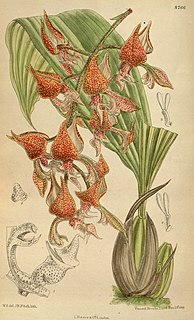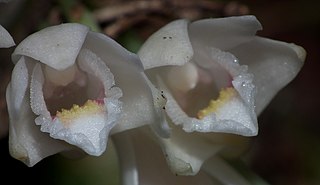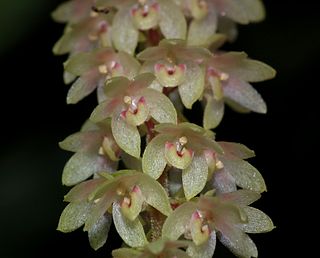
Gongora, abbreviated Gga in horticultural trade, is a member of the orchid family (Orchidaceae). It consists of 65 species known from Central America, Trinidad, and tropical South America, with most species found in Colombia. They grow in wide geographical range from wet forests at sea level to mountainous regions in the Andes, as high as 1,800 m.

Grammatophyllum, sometimes abbreviated in horticultural trade as Gram, is a genus of 13 currently known orchid species. The name is derived from the Greek words 'gramma' and 'phyllon' (leaf), referring to the parallel leaf veins or the markings of the perianth. This epiphytic genus occurs in dense rainforest from Indo-China, to Indonesia, the Philippines, New Guinea, and the Southwest Pacific islands.

Grammatophyllum speciosum, also called giant orchid, tiger orchid, sugar cane orchid or queen of the orchids, is a species of orchid native to Laos, Myanmar, Thailand, Vietnam, Borneo, Indonesia and Malaysia. It has also been recorded in the Philippines, New Guinea and the Solomon Islands. It is listed by the Guinness Book of World Records as the world's tallest orchid, with specimens recorded up to 7.62 metres (25 ft) in height.

Ansellia is considered a monotypic genus of orchid, with only one species, Ansellia africana, commonly known as African ansellia or leopard orchid, however, it may in fact be a complex group of species which share common floral structure and growth habit.

Paphinia herrerae is a species of orchid endemic to southeastern Ecuador.

Encyclia tampensis or Tampa butterfly orchid is a species of flowering plant in the orchid family, subfamily Epidendroideae.

Dendrobium kingianum, commonly known as the pink rock orchid, is a flowering plant in the orchid family Orchidaceae and is endemic to eastern Australia. It usually grows on rocks, rarely as an epiphyte, and has thin, spreading leaves and spikes of up to fifteen, usually pink flowers in late winter to spring. It is popular in Australian native horticulture and is a commonly cultivated orchid among Australian orchid species growers.

Pinalia, commonly known as gremlin orchids, is a genus of flowering plants in the family Orchidaceae. Orchids in this genus are large epiphytic or lithophytic plants with prominent pseudobulbs, each with up to three thin, flat leaves and cup-shaped, relatively short-lived flowers with scale-like brown hairs on the outside. There are about 120 species occurring from tropical to subtropical Asia to the south-west Pacific.

Dendrobium validicolle is a species of orchid. Its common name is the strong-stemmed diplocaulobium.

Cattleya maxima is a species of orchid in subfamily Epidendroideae found from Ecuador to Peru.

Pinalia floribunda is a species of orchid found in Myanmar, Thailand, Vietnam, Malaysia, Indonesia and the Philippines in montane forests at elevations of 500 to 2400 meters above sea level. It is a small to medium-sized, warm-to-cold growing epiphyte found on large trees along streams. It has erect, stem-like, narrow ellipsoid pseudo-bulbs carrying soft leaves that flower in the spring.

Psychopsiella is a monotypic genus in the orchid family found only in the state of Rio de Janeiro in Brazil and near Caracas in Venezuela. It grows as an epiphyte in evergreen montane forests at elevations of 800 to 1,500 metres.

Dendrobium milaniae is flower of the Orchid family found in Leyte, Visayas in the Philippines, where it is found growing as an epiphyte above bodies of water at elevations up to 600 metres. The flower grows to approximately 1.5 centimetres (0.59 in). The plant is semi-pendulous and sympodial. Pseudobulbs are 10 cm by 2 cm; 3 to 6 green lanceolate leaves are present on the top third of the pseudobulb. Hans Fessel and Emil Lückel named this species in 1996 in Die Orchidee.

Acanthophippium mantinianum or Mantin's acanthophippium, is a species of the family Orchidaceae. It is currently the only endemic Acanthophippium species known in the Philippines and one of the two species along with Acanthophippium pictum. It was named in honor of M. Georges Mantin, an orchid horticulturalist and hybridizer from Olivet, France. It is an erect and sympodial species with 15 cm long tapering pseudobulbs and large, thin leaves, which can be up to 60 cm long and 15 cm wide. The plant is endemic to the islands of Luzon, Leyte, Mindoro, Negros and Panay in the Philippines where it is found at elevations from 500 to 1500 meters.

Grammatophyllum martae is a species of orchid in the family Orchidaceae. It is endemic to the Philippines.

Pinalia ovata is a species of orchid found from the Ryukyu Islands and Taiwan to the Philippines. It is an epiphyte that is found growing from 500 to 2,550 meters elevation. This species is erect and sympodial with pseudobulbs of 20 cm long by 1.2 cm diameter. It has about 4 leaves that are linear-oblong to oblong-lanceolate of 15 cm long and 2.1 cm wide.

Dendrobium bullenianum is a member of the family Orchidaceae found in the Philippines and Vietnam. It is named in honor of Mr. Bullen, orchid cultivator with Low & Co.'s nursery, who was first in Britain get this species to flower in cultivation. It is pendulous and sympodial with 1 meter long pseudobulbs of 1.5 cm thickness and deciduous leaves of 10 cm by 1.5 cm. Heinrich Gustav Reichenbach was the first to describe this species in 1862 in Botanische Zeitung. It is found as an epiphyte in elevations up to 1,000 metres in Luzon and Mindoro in the Philippines.

Pinalia polyura, or many-tailed pinalia, is a member of the orchid family endemic to the Philippines. It is semi-pendulous and sympodial, with pseudobulbs that are 20 cm long, 1 cm in diameter, and somewhat club shaped. Each new growth begins halfway along the previous year's pseudobulbs, making the plant longer each year. Each pseudobulb has about 5 shiny, lanceolate leaves approximately 15 cm long and 2 cm wide. Inflorescences appear at the upper portion of the plant and are pendulous, about 10 cm long and bear up to 40 flowers each 1.5 cm in diameter. It grows as an epiphyte and sometimes as a semi-terrestrial plant at elevations to 2,400 meters.

Trichoglottis atropurpurea, the dark purple trichoglottis, is a species of orchid endemic to the Philippines. This hot to warm growing epiphyte was first found growing in mangrove swamps in the islands of Biliran, Catanduanes, Mindanao and Polillo. The plant shares the same appearance with T. philippinensis except for the rich dark color of the blooms and slight variation of the perianth. This species was first described in 1877 by the German botanist Heinrich Gustav Reichenbach, an expert on the orchid family. At that time, thousands of newly discovered orchids were being sent back to Europe, and he was responsible for identifying, describing and classifying many of these new discoveries.
Pinalia moluccana, synonym Eria kingii, commonly known as the common gremlin orchid, is a plant in the orchid family and is an epiphyte or lithophyte with crowded pseudobulbs, each with three or four thin, channelled leaves. Up to fifty white or cream-coloured, cup-shaped flowers with hairy exteriors are arranged along an erect flowering stem. It is native to areas between Sulawesi and tropical North Queensland.


















